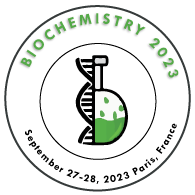Molecular Biology and Material Science:
The mitochondrion, the chloroplast, the ribosome, and the replication and transcription complexes are all made up of nanostructures, which are the basic machines that power the cell's histones and proteasomes. Nanostructures are the pores and templates of zeolites and other crucially important structures in catalysis. The highest length scale over which a crystal may frequently be rendered virtually flawless is the nanometre. A completely new generation of sophisticated composites is possible if it is possible to perfectly control how impurities and imperfections interact with one another and therefore merge flawless inorganic and organic nanostructures.
Related Conference of Molecular Biology and Material Science:
Molecular Biology and Material Science: Conference Speakers
Recommended Sessions
- Medical Genetics:
- Nutritional and Clinical Biology:
- Pharmaceutical and Medicine Biochemistry:
- Protein and Analytical Biochemistry:
- Biochemistry for Material Science:
- Cardiovascular Biochemistry:
- Chemical Biology and Computational Chemistry:
- Clinical Pathology:
- COVID 19 and Biochemistry:
- Enzymology and Biochemistry:
- Enzymology in Molecular Biology:
- Lipids and Metabolism:
- Molecular and Cellular Biology:
- Molecular and Structural Biochemistry:
- Molecular Biology and Material Science:
- Molecular Virology:
- Nano Biochemistry:
- Pharmacology and Toxicology:
- Plant Animal Biochemistry:
- Structural Biochemistry:
- Structural Molecular Biochemistry and Structural Bioinformatics:
- Study of a set of proteins in Biochemistry and Molecular Biology:
Related Journals
Are you interested in
- 3D Structure Determination - Structural Biology-2026 (France)
- Advanced Techniques in Structural Biology - Structural Biology-2026 (France)
- AI & Computational Structural Biology - Structural Biology-2026 (France)
- Biochemistry and Biophysics - Structural Biology-2026 (France)
- Computational Approach in Structural Biology - Structural Biology-2026 (France)
- Drug Designing and Biomarkers - Structural Biology-2026 (France)
- Hybrid Approaches for Structure Prediction - Structural Biology-2026 (France)
- Membrane Proteins and Receptors - Structural Biology-2026 (France)
- Molecular Modelling and Dynamics - Structural Biology-2026 (France)
- Proteomics and Genomics - Structural Biology-2026 (France)
- Structural Bioinformatics and Computational Biology - Structural Biology-2026 (France)
- Structural Biology in Cancer Research - Structural Biology-2026 (France)
- Structural Virology - Structural Biology-2026 (France)
- Structural Virology and Infectious Diseases - Structural Biology-2026 (France)
- Structure-Based Drug Discovery - Structural Biology-2026 (France)
- Structure-Based Solutions to Global Health Challenges - Structural Biology-2026 (France)
- Structure-Function Relationships - Structural Biology-2026 (France)
- The Structural Basis of Disease - Structural Biology-2026 (France)

